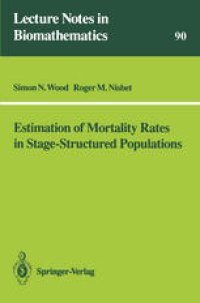
Ebook: Estimation of Mortality Rates in Stage-Structured Population
- Tags: Demography, Methodology of the Social Sciences, Anthropology, Mathematical and Computational Biology
- Series: Lecture Notes in Biomathematics 90
- Year: 1991
- Publisher: Springer-Verlag Berlin Heidelberg
- Edition: 1
- Language: English
- pdf
The stated aims of the Lecture Notes in Biomathematics allow for work that is "unfinished or tentative". This volume is offered in that spirit. The problem addressed is one of the classics of statistical ecology, the estimation of mortality rates from stage-frequency data, but in tackling it we found ourselves making use of ideas and techniques very different from those we expected to use, and in which we had no previous experience. Specifically we drifted towards consideration of some rather specific curve and surface fitting and smoothing techniques. We think we have made some progress (otherwise why publish?), but are acutely aware of the conceptual and statistical clumsiness of parts of the work. Readers with sufficient expertise to be offended should regard the monograph as a challenge to do better. The central theme in this book is a somewhat complex algorithm for mortality estimation (detailed at the end of Chapter 4). Because of its complexity, the job of implementing the method is intimidating. Any reader interested in using the methods may obtain copies of our code as follows: Intelligible Structured Code 1. Hutchinson and deHoog's algorithm for fitting smoothing splines by cross validation 2. Cubic covariant area-approximating splines 3. Cubic interpolating splines 4. Cubic area matching splines 5. Hyman's algorithm for monotonic interpolation based on cubic splines. Prototype User-Hostile Code 6. Positive constrained interpolation 7. Positive constrained area matching 8. The "full method" from chapter 4 9. The "simpler" method from chapter 4.
This book addresses one of the major ''inverse'' problems in population ecology - that of inferring mortality rates from time series of population numbers for a set of age classes or developmental stages. The authors set out to provide a useful method for field ecologists, and a framework from which to approach such problems in future. After a survey of previously published methods, an analysis is given of some basic instabilities that arise in the process of mortality estimation from stage structured population data. A concise introduction to spline theory, and the derivation of some new results enables these instabilities to be overcome in a biologically sensible way. The resulting methods are then tested on simulated data, and their performance compared with that of previous methods. Finally a real system with three zooplankton species is investigated using the new methods.